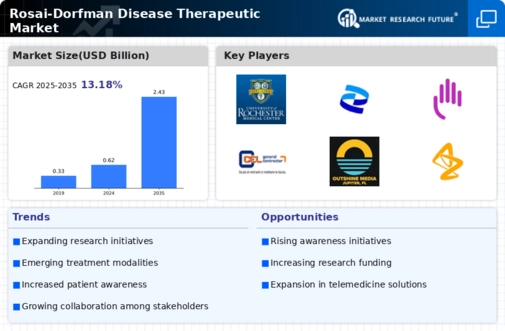Advancements in Diagnostic Techniques
Advancements in diagnostic techniques are significantly influencing the Rosai-Dorfman Disease Therapeutic Market. Enhanced imaging technologies and histopathological methods have improved the accuracy of diagnosing this rare disease. As diagnostic capabilities evolve, more cases are likely to be identified, which could lead to an increase in treatment-seeking behavior among patients. The ability to diagnose Rosai-Dorfman Disease more effectively may also encourage healthcare providers to explore novel therapeutic options, thereby expanding the market. Moreover, the integration of molecular diagnostics could facilitate personalized treatment approaches, aligning with the current trend towards precision medicine in oncology and hematology.
Growing Incidence of Rosai-Dorfman Disease
The increasing incidence of Rosai-Dorfman Disease is a notable driver for the Rosai-Dorfman Disease Therapeutic Market. Recent studies indicate that the disease, characterized by an overproduction of histiocytes, is being diagnosed more frequently, leading to a heightened demand for effective therapeutic options. As awareness of this rare condition expands among healthcare professionals, the number of diagnosed cases is likely to rise. This trend suggests a growing patient population that requires targeted treatments, thereby stimulating market growth. Furthermore, the need for specialized therapies tailored to the unique pathophysiology of Rosai-Dorfman Disease could lead to increased investment in research and development, further propelling the market forward.
Collaboration Between Academia and Industry
Collaboration between academia and industry is emerging as a vital driver for the Rosai-Dorfman Disease Therapeutic Market. Partnerships between research institutions and pharmaceutical companies facilitate the sharing of knowledge, resources, and expertise, which can accelerate the development of new therapies. Such collaborations often lead to innovative research initiatives focused on understanding the underlying mechanisms of Rosai-Dorfman Disease, paving the way for targeted treatment strategies. Additionally, these partnerships may enhance the clinical trial process, enabling faster recruitment and more efficient data collection. As the landscape of Rosai-Dorfman Disease research evolves, these collaborative efforts are likely to yield promising therapeutic advancements.
Growing Patient Advocacy and Support Groups
The rise of patient advocacy and support groups is playing a crucial role in shaping the Rosai-Dorfman Disease Therapeutic Market. These organizations are instrumental in raising awareness about the disease, providing education to patients and healthcare providers, and advocating for research funding. By fostering a community of support, these groups empower patients to seek timely diagnosis and treatment, which may lead to increased demand for therapeutic options. Furthermore, advocacy efforts can influence policy changes and encourage pharmaceutical companies to prioritize the development of therapies for Rosai-Dorfman Disease. As the visibility of the disease increases, the market is likely to experience growth driven by informed patients and engaged stakeholders.
Increased Investment in Rare Disease Research
The surge in investment for rare disease research is a critical driver for the Rosai-Dorfman Disease Therapeutic Market. Pharmaceutical companies and research institutions are increasingly allocating resources to develop therapies for rare conditions, including Rosai-Dorfman Disease. This trend is partly fueled by regulatory incentives, such as orphan drug designations, which provide financial benefits and market exclusivity for developers. As a result, the number of clinical trials targeting Rosai-Dorfman Disease is expected to rise, potentially leading to the introduction of innovative treatment options. This influx of investment not only enhances the therapeutic landscape but also raises awareness about the disease, further driving market growth.


















Leave a Comment